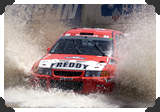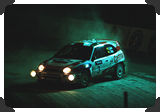|
|
|
|
 |
After support from government of Western Australia ran out in 2006 and Rally Australia was dropped from the WRC calendar, the former organizing team led by Garry Connelly began to look for a new home for the event. Initially, it was planned to make a return for 2008 in Australian East Coast at Queensland but that failed to materialize. Fortunately, new home was found a little bit of south of there across the state border at small town of Kingscliff.
The new event showed almost the same level of organizing excellence that Connelly's team proved to be able to deliver earlier but the character of the event was very different. Gone was the slippery bauxite ball-bearing surface and gone was the narrow tree-lined stages in wood plantations.
The route in New South-Wales is over open ground in larger part than that around Perth - which coupled with lack of slippery surface results higher overall speeds. Organization has small teething problems, as can be expected. The first "new" edition in 2009 also suffered from protests by environmental activists but fortunately this problem proved to be limited.
For 2011, event again changed location - albeit only little this time - by migrating further south in Australian East Coast.
|
|
|
 |
 Australia has relatively short history in WRC, having been full standing member since 1989. Event is widely liked by drivers, teams and fans. It has won the Rally of the Year Award for a number of times and is known for high level of professionalism in organisation. Much of which is thanks to long-standing Clerk of the Course Garry Connelly who unfortunately resigned in December 2002 having had enough of nonsense with local politicians. Australia has relatively short history in WRC, having been full standing member since 1989. Event is widely liked by drivers, teams and fans. It has won the Rally of the Year Award for a number of times and is known for high level of professionalism in organisation. Much of which is thanks to long-standing Clerk of the Course Garry Connelly who unfortunately resigned in December 2002 having had enough of nonsense with local politicians.
For a driver Rally Australia represents a unique challenge for two reasons. Firstly, gravel roads are covered with small, round, ball-bearing like bauxite pebbles. These stones make roads extremely slippery for first cars, offering significant advantage for those coming later in the running order. That's why Rally Australia has seen some of the fiercest tactical games as drivers have been tumbling over each others to avoid running first in the road.
Secondly, in places roads are quite narrow and trees are very close to the road. Combine that with the slippery surface and drivers have very little room for error. Francois Delecour, or rather his co-driver Daniel Grataloup, has fallen foul of this. In 2001 he crashed his Ford Focus on a tree, injuring co-driver in the process. Year later, his Mitsubishi Lancer WRC hit a concrete block on a very fast left hander and careened into trees, again injuring unlucky Daniel.
One of the most famous scenes of Rally Australia is the much filmed watersplash at the end of the final stage and the jumps before it. On a picture (right top) Freddy Loix makes waves with his Mitsubishi Carisma GT, year is 1999. The other famous scene is, of course, the Langley Park Super Special. For over a decade Langley Park hosted spectator super special and became most famous of all SSS's. On a picture (right bottom) Carlos Sainz in Toyota Corolla WRC tackles the stage in 1999.
|
|
|
 |
|
|
 |
| 1989:
|
Kankkunen, Juha
|
Toyota Celica GT-4 (ST165)
|
98.32 km/h
|
| 1990:
|
Kankkunen, Juha
|
Lancia Delta HF Integrale 16v
|
99.53 km/h
|
| 1991:
|
Kankkunen, Juha
|
Lancia Delta HF Integrale 16v
|
101.94 km/h
|
| 1992:
|
Auriol, Didier
|
Lancia Delta HF Integrale
|
102.80 km/h
|
| 1993:
|
Kankkunen, Juha
|
Toyota Celica Turbo 4WD (ST185)
|
103.27 km/h
|
| 1995:
|
Eriksson, Kenneth
|
Mitsubishi Lancer Evo III
|
102.67 km/h
|
| 1996:
|
Makinen, Tommi
|
Mitsubishi Lancer Evo III
|
99.98 km/h
|
| 1997:
|
McRae, Colin
|
Subaru Impreza WRC97
|
102.99 km/h
|
| 1998:
|
Makinen, Tommi
|
Mitsubishi Lancer Evo V
|
104.30 km/h
|
| 1999:
|
Burns, Richard
|
Subaru Impreza WRC99
|
105.79 km/h
|
| 2000:
|
Gronholm, Marcus
|
Peugeot 206WRC (2000)
|
104.80 km/h
|
| 2001:
|
Gronholm, Marcus
|
Peugeot 206WRC (2001)
|
107.00 km/h
|
| 2002:
|
Gronholm, Marcus
|
Peugeot 206WRC (2002)
|
107.98 km/h
|
| 2003:
|
Solberg, Petter
|
Subaru Impreza WRC2003
|
109.27 km/h
|
| 2004:
|
Loeb, Sebastien
|
Citroen Xsara WRC
|
105.99 km/h
|
| 2005:
|
Duval, Francois
|
Citroen Xsara WRC
|
106.55 km/h
|
| 2006:
|
Hirvonen, Mikko
|
Ford Focus RS WRC 06
|
107.13 km/h
|
| 2009:
|
Hirvonen, Mikko
|
Ford Focus RS WRC 09
|
111.63 km/h
|
| 2011:
|
Hirvonen, Mikko
|
Ford Fiesta RS WRC
|
102.50 km/h
|
| 2013:
|
Ogier, Sebastien
|
Volkswagen Polo R WRC
|
105.75 km/h
|
| 2014:
|
Ogier, Sebastien
|
Volkswagen Polo R WRC
|
105.37 km/h
|
| 2015:
|
Ogier, Sebastien
|
Volkswagen Polo R WRC
|
104.21 km/h
|
| 2016:
|
Mikkelsen, Andreas
|
Volkswagen Polo R WRC
|
102.37 km/h
|
| 2017:
|
Neuville, Thierry
|
Hyundai i20 Coupe WRC
|
110.78 km/h
|
| 2018:
|
Latvala, Jari-Matti
|
Toyota Yaris WRC
|
106.29 km/h
|
|
|
 |
Route in Eastern Australia is run through more open ground and roads are generally quite fast.
 |
 |
Loix crossing the final watersplash
 |
 |
Typical forest road, narrow and slippery with trees right on the edge of the road ready to catch unwary drivers.
 |
 |
Langley Park SSS
 |
|
Driver wins
|
Kankkunen, Juha (4)
Gronholm, Marcus (3)
Hirvonen, Mikko (3)
Ogier, Sebastien (3)
Makinen, Tommi (2)
Auriol, Didier (1)
Burns, Richard (1)
Duval, Francois (1)
Eriksson, Kenneth (1)
Latvala, Jari-Matti (1)
Loeb, Sebastien (1)
McRae, Colin (1)
Mikkelsen, Andreas (1)
Neuville, Thierry (1)
Solberg, Petter (1)
|
|
Manufacturer wins
|
Volkswagen (4)
Ford (3)
Lancia (3)
Mitsubishi (3)
Peugeot (3)
Subaru (3)
Toyota (3)
Citroen (2)
Hyundai (1)
|
|
Economic impact
|
|
Rally Australia officials estimated that event brought in AU$11.2 million direct spending cashflow for Western Australia in 2002. Cumulative economical impact is even higher.
|
|